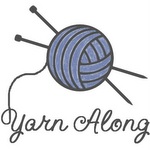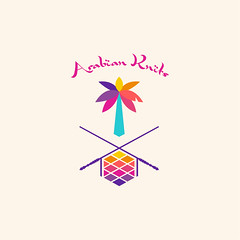Wednesday, August 21, 2024
Craft On: Second Hump

I am actually nearly finished with this second pair of Jamal mitts, in the Bactrian variation. The pattern should be ready for publication in a couple days, and I will have a great coupon code for everyone. (See the link to subscribe to my newsletter below, if you don't already, for the earliest access to coupons and sales).
Besides this, I have started a crocheted scrap yarn basket to use up some bits and bobs of DK and worsted (mostly) yarns that I have had hanging around here for a while. My destash plans are continuing apace. I have only bought about a quarter of what I have used or destashed so far this year, and don't expect to be buying a whole lot of yarn this year.
I finished Knitmare on Beech Street. It was a fun read, and not too Encylopedia Brown in its solution. However, I am a little frustrated with the author. She actually did this in the previous book, but was evidently not satisfied with that and had to mention it briefly again in this book. She proclaimed the "facts" that "everyone knows" about how Easter/Pascha is really a pagan celebration. This is utter nonsense.
The entire theory was created by a 19th century occultist (much like the claims that the feast of the Nativity was a co-opting or secret celebration of Pagan feasts/deities), who made it up whole cloth, and was utterly debunked. However, the accusation lingers, because of angry secularists and the anti-Catholic Protestants who will make partnership with them to get a jab at Catholics. Serious historians, even non-Christians, even non-theists, even non-religious ones, all know this is ridiculous. One does not have to believe that Jesus is God, or that He was raised from the dead, to know that the celebration of the Paschal feast is historic, Christian, and has nothing to do with Germanic or Ango-Saxon/Celtic mythology. For one, it was celebrated long before Christians had contact with those people groups. For another, the whole Easter=Eostre garbage is bizarre, as that is only the word in Germanic languages (German, English, and I think one Nordic language, perhaps, as well), and that "pagan" word was simply the word for the month and season in which the feast normally fell. It is the word for Spring. We don't even know that the word refers to a pagan deity. That is speculation. However, even if it did, that doesn't mean that is what is really being celebrated (or co-opted) by Christians, any more than celebrating the Fourth of July is really a tribute to the Pagan Roman Caesar Julius. There used to be a wonderful website online, footnoted, that gave historic and religious reasons for Christian celebration of the Paschal feast, but it went away. A blog that catalogues most of the rebuttals (from a pagan, no less) can be found on the wayback machine here - be sure to check the links at the bottom of that post for even more information debunking this modern mythology, but I haven't been able to get the footnoted one since the internet ate it (there is one for Christmas that was put out by an honest atheist, which also disappeared, but was preserved by an Orthodox blogger, who added his own devotional text after all the facts and footnotes). However, note that the word Pascha (which is the word, in various languages, in nearly every culture and language for the feast) is derived from Passover. Because Christ OUR Passover is sacrificed for us. Italian, Spanish, French, Romanian, Greek, Arabic, Hebrew, Russian, Serbian, Croatian, ALL languages except for English and German (and maybe that one Nordic language) call this feast Passover. And the eggs? They came from the Passover Seder. The dyeing of the eggs began because of a miracle of Saint Mary Magdalene and initially (and still in much of the world) was not pastel spring colors, but was blood red, because of the blood of Christ. There were also iconic depictions and other decorations (like Pysanky) which developed. The pastel spring colors also come from later tradition that is just fun, and I believe in the 20th century.
In short: Ishtar is not pronounced Easter. Constantine did not Christianize the empire, the Edict of Milan simply made it so that being a Christian was no longer a capital offense against the state. Ishtar's symbols did not involve eggs or bunnies. They were the lion, the gate, and the eight pointed star. The reason Christians have eggs at Pascha (as Constantine himself would have called it, being a Greek speaker) or Easter is because of Passover's use of the eggs, and the miracle wrought by St. Mary Magdalene explaining Christ's blood shed for sin and resurrection. The commemoration of the passion and resurrection of Christ is the earliest celebration and feast of Christian history. If Fes-h'a/Fesih’ (Arabic) was about fertility and sex, there would be much less eating and chocolate and much more sex, to be blunt. Ishtar, after all, did have temple prostitution as part of her cult.
All that said, it was a brief mention in this book, though it had more prolonged visibility in the previous one, and I am assuming/hoping it won't come up in later books. In the meantime, I will be returning to Milk: The Surprising Story of Milk Through the Ages for my evening reading.

Linking to Unraveled Wednesday
If you would like to receive updates and early notice of new patterns, beta knitting opportunities, and great discounts (plus pictures of new yarns, new tools, fun places, neat hints, book ideas, recipes and more) each month, please subscribe to 1,001 Knits. My best, and sometimes my only, discounts go to my subscribers.
Labels: Around the World Stitch Along, Books, Crochet, Design, Faith and Morality, Homemaking, Knitting, WIP, Yarn Along


